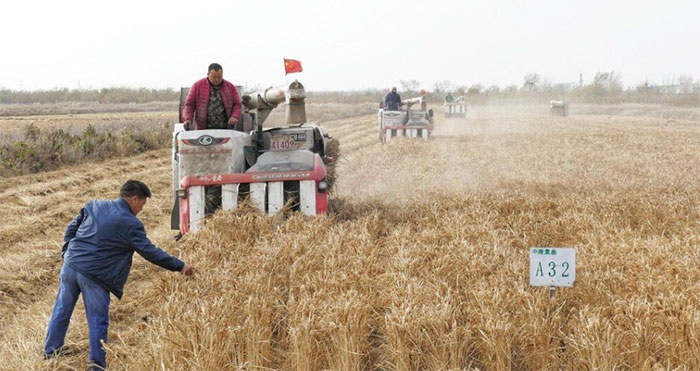China develops 'sea rice' with high salt tolerance
Chinese scientists have developed salt-tolerant rice that can be grown near the sea to ensure food security in the face of many challenges from climate change.
Recently, Chinese media published many information and pictures of people harvesting rice crops with good salt tolerance along the northeastern coast of this country. The story of the miracle rice variety also attracted a lot of attention in the Western media.
The fields of "sea rice"
Jinghai District in Tianjin City, northern China is a land that is hardly suitable for rice cultivation.
Located along the Bohai coast, more than half of the land here is saline, alkaline soil, making it difficult for plants to survive. However, last fall, Tinh Hai planted and harvested 100ha of rice.

People harvest 'sea rice' at a farming facility in Jinghai district, Tianjin city (China) in November 2021.
The secret of this bountiful rice crop is a new salt-tolerant rice variety developed by the late scientist Vien Long Binh and his research team.
The rice variety was born with the hope of ensuring food security, which is threatened by rising sea levels, increased food demand and broken supply chains.
The new rice variety is called "sea rice" (technical name is "salt-tolerant, alkaline rice") because it is grown in saline soil near the sea. Rice is created from the genes of a selected wild rice variety with good resistance to salinity and alkalinity.
The crop marks the initial success in the experimental planting phase of the "sea rice" project. The trial fields in Tianjin City yielded more than 11 tonnes per hectare last year, well above the national average for production of standard rice varieties.
The breakthrough comes as China seeks to secure domestic food and energy supplies against the effects of climate change. The country is home to one-fifth of the world's population but occupies only about 10% of the world's arable land.
Coastal waters in China have risen faster than the global average over the past 40 years. This is a worrying trend for China as it mainly grows rice in the long and low-lying eastern coastal region.
Successfully planting salt-tolerant rice on a large scale will help them not waste the increasing area of saline soil.
The "chip" of agriculture
Conventional rice varieties cannot grow in a field environment containing more than 0.3% salt. Normally, to make use of saline soil, farmers have to wash salt. But this approach, which is still practiced in some places, consumes a lot of fresh water and often does not improve yields.
However, "sea rice" can grow in environments with a salt content of more than 0.3%. Tran Duong Phac, general manager of an agricultural company in Tianjin, said there are more than 13,300 square kilometers of saline and alkaline soil in and around Tianjin, in areas around the Bohai Sea.
Ms. Van Cat Le, a manager at Qingdao Center for Research and Development of Saline and Alkaline Rice, compares: "Seeds are the 'chip' of agriculture".
According to Ms. Van, "sea rice" can help improve China's rice production in the "extremely complicated situation related to climate change and global food security".
China has been studying salt-tolerant rice since at least the 1950s. However, the term "sea rice" only started to gain attention in recent years after Mr. Yuan Longping, China's leading agricultural scientist. Quoc, started studying them in 2012.
Mr. Vien is considered the "father of hybrid rice" and made a major contribution to saving millions from hunger through his research on high-yielding hybrid rice varieties in the 1970s.
In 2016, he selected six sites across China with different soil conditions to test salt-tolerant rice.
A year later, China established a research center in Qingdao with the goal of harvesting 30 million tons of rice on 6.7 million hectares of barren land. "Agricultural researchers like us should shoulder the responsibility of ensuring food security," Vien told the media in 2018.
According to Bloomberg, a researcher at China's Ministry of Agriculture said that "sea rice" has been mainly grown in experimental fields so far, and he believes commercial farming will soon succeed in China thanks to the government. support.
"Sea rice": the future of food security?
According to Radio CGTN, if China grows "sea rice" on 1/10 of the country's saline and alkaline soil, it could increase the country's rice production by nearly 20% - enough to feed 200 million people.
Worldwide, 1 billion hectares of land are already saline and about 10 million more are added each year. CGTN commented: "If sea rice can really turn these areas into fertile land, it will not only ensure national food security in China, but also help the long-term future. global hunger".
- The United States found high levels of lead in Chinese rice
- Discovering rice varieties that are 'resistant' to climate change
- It is expected that by 2021, humanity will have the first saline tolerant rice bowl
- China successfully researched 'sea rice', capable of raising 80 million people
- China genetically engineered rice to increase productivity
- Maize culture has high salinity tolerance
- Rice varieties with salinity and high yield
- Successfully planted saline tolerant rice in Dubai
- China produces rice varieties higher than human heads for high productivity
- Discovering new rice varieties with antioxidant capacity
- Genetically modified rice is rampant in China
- Too high CO2 levels can cause rice to lose many important nutrients?
 Why do potatoes have eyes?
Why do potatoes have eyes? 'Tragedy' the world's largest carnivorous life: Death becomes ... public toilet
'Tragedy' the world's largest carnivorous life: Death becomes ... public toilet Tomatoes were once considered 'poisonous' for 200 years
Tomatoes were once considered 'poisonous' for 200 years Detecting microscopic parasites on human face
Detecting microscopic parasites on human face